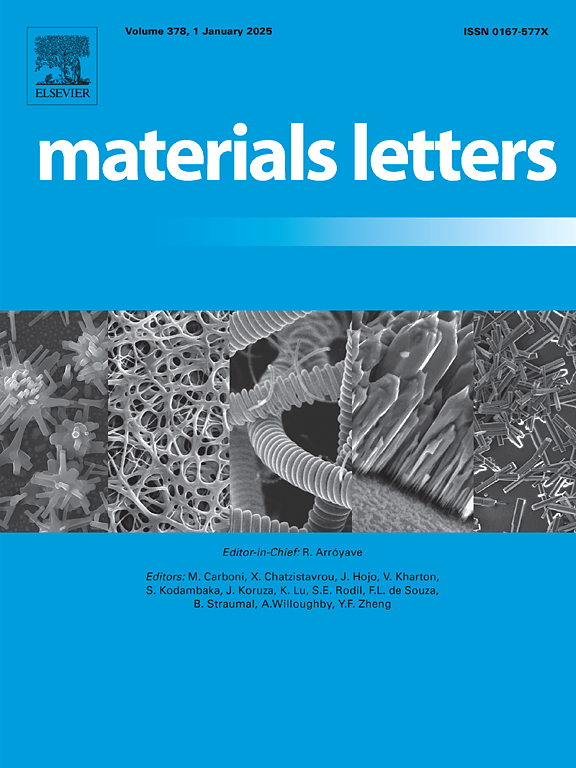高熵(La0.2Nd0.2Y0.2Eu0.2Gd0.2)2Zr2O7锆酸盐陶瓷在Na2SO4-V2O5熔盐中的腐蚀行为
IF 2.7
4区 材料科学
Q3 MATERIALS SCIENCE, MULTIDISCIPLINARY
引用次数: 0
摘要
成功合成了一种新型高熵(La0.2Nd0.2Y0.2Eu0.2Gd0.2)2Zr2O7 (RE2Zr2O7)焦绿石结构锆酸盐陶瓷,研究了其在Na2SO4-V2O5熔盐中1000℃腐蚀20 h的行为和机理。结果表明:腐蚀层厚度约为17.5 μm;在高温熔盐腐蚀环境下,陶瓷中的稀土离子(RE3+)从RE2Zr2O7晶格中析出,与熔盐中游离的VO43−离子反应生成棒状稀土钒酸盐(REVO4)。离子半径较大的RE3+由于其在晶格中的结合力较弱,更容易析出并优先参与反应。同时,残余的Zr4+与O2−结合形成稳定的ZrO2, ZrO2分布在棒状REVO4之间的间隙形成富zr区。本文章由计算机程序翻译,如有差异,请以英文原文为准。
Corrosion behavior of a high-entropy (La0.2Nd0.2Y0.2Eu0.2Gd0.2)2Zr2O7 zirconate ceramic in Na2SO4-V2O5 molten salt
A novel high-entropy (La0.2Nd0.2Y0.2Eu0.2Gd0.2)2Zr2O7 (RE2Zr2O7) zirconate ceramic with a pyrochlore structure was successfully synthesized, its corrosion behavior and mechanism in Na2SO4-V2O5 molten salt at 1000 °C for 20 h were investigated. The results indicate that the thickness of the corrosion layer is approximately 17.5 μm. Under high-temperature molten salt corrosion environment, rare earth ions (RE3+) in the ceramic precipitate from the RE2Zr2O7 lattice and react with dissociated VO43− ions in the molten salt to form rod-shaped rare earth vanadates (REVO4). RE3+ with larger ionic radii are more likely to precipitate and preferentially participate in the reaction due to the weaker bonding force in the crystal lattice. Meanwhile, the residual Zr4+ combine with O2− to form stable ZrO2, which distributes in the gaps between the rod-shaped REVO4 to form Zr-rich regions.
求助全文
通过发布文献求助,成功后即可免费获取论文全文。
去求助
来源期刊

Materials Letters
工程技术-材料科学:综合
CiteScore
5.60
自引率
3.30%
发文量
1948
审稿时长
50 days
期刊介绍:
Materials Letters has an open access mirror journal Materials Letters: X, sharing the same aims and scope, editorial team, submission system and rigorous peer review.
Materials Letters is dedicated to publishing novel, cutting edge reports of broad interest to the materials community. The journal provides a forum for materials scientists and engineers, physicists, and chemists to rapidly communicate on the most important topics in the field of materials.
Contributions include, but are not limited to, a variety of topics such as:
• Materials - Metals and alloys, amorphous solids, ceramics, composites, polymers, semiconductors
• Applications - Structural, opto-electronic, magnetic, medical, MEMS, sensors, smart
• Characterization - Analytical, microscopy, scanning probes, nanoscopic, optical, electrical, magnetic, acoustic, spectroscopic, diffraction
• Novel Materials - Micro and nanostructures (nanowires, nanotubes, nanoparticles), nanocomposites, thin films, superlattices, quantum dots.
• Processing - Crystal growth, thin film processing, sol-gel processing, mechanical processing, assembly, nanocrystalline processing.
• Properties - Mechanical, magnetic, optical, electrical, ferroelectric, thermal, interfacial, transport, thermodynamic
• Synthesis - Quenching, solid state, solidification, solution synthesis, vapor deposition, high pressure, explosive
 求助内容:
求助内容: 应助结果提醒方式:
应助结果提醒方式:


